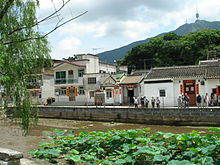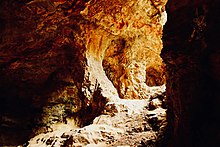
| Lin Ma Hang | |||||||||||||
|---|---|---|---|---|---|---|---|---|---|---|---|---|---|
| Traditional Chinese | 蓮麻坑 | ||||||||||||
| Cantonese Yale | lìhn màh hāang | ||||||||||||
| |||||||||||||

Lin Ma Hang (Chinese: 蓮麻坑) is a village in the Sha Tau Kok area of Hong Kong and is situated north of the New Territories, next to the Shenzhen river, east of Heung Yuen Wai and west of Hung Fa Leng.
Administration
Lin Ma Hang is a recognized village under the New Territories Small House Policy. It is one of the villages represented within the Ta Kwu Ling District Rural Committee. For electoral purposes, Lin Ma Hang is part of the Sha Ta constituency, which is currently represented by Ko Wai-kei.
History

People originated in the village are the Yip (葉) (or Ip, Yap, Yapp), Lau (劉), Sin (冼) and Koon (官) (or Kwun). It is named after a fruit called Lin Ma (蓮麻) that can be found in the mid-level streams.
Lin Ma Hang is part of the Four Yeuk (四約; 'Four Villages Alliance'), which comprises Loi Tung, Lung Yeuk Tau, Lin Ma Hang and Tan Chuk Hang. The centre of the Alliance is the Hung Shing Temple at Hung Leng.
At the time of the 1911 census, the population of Lin Ma Hang was 516. The number of males was 199.
Abandoned lead mine

A lead mine was in operation in Lin Ma Hang starting in 1915. Pb–Zn ore was mined there. The mine operated intermittently between 1915 and 1958, producing 16,000 tonnes of lead metal and 360,000 ounces of silver. The Government rescinded the mining lease in 1962 and the mine was abandoned the same year.
Fauna and flora
The abandoned lead mine now holds one of the most important bat colonies in Hong Kong, and was designated as a Site of Special Scientific Interest (SSSI) in 1994.
The Lin Ma Hang Stream was designated as a SSSI in 2008. It supports 17 species of primary freshwater fish, representing 50% of all such species native to Hong Kong.
The village is situated in the basin of the Robin's Nest (Chinese: 紅花嶺) which is famous for its abundance in "Hanging Bell Flowers" (吊鐘花).
Building heritage

- The Residence of Ip Ting-sz is a declared monument
- Old Bridge, Grade 3 historic building
- Ip Ancestral Hall, Grade 3 historic building
- Koon Ancestral Hall, Grade 3 historic building
- Kwan Tai Temple, not graded
- Lau Ancestral Hall, not graded
- MacIntosh Fort on Kong Shan above Lin Ma Han, Grade 2 historic building
Access
Until 4 January 2016, the village was situated in the Frontier Closed Area and was therefore inaccessible to non-permit holders.

Since 4 January 2016, the village was excluded from the Frontier Closed Area. Nonetheless, a portion of Lin Ma Hang Road, the access road to the village, between Wang Lek and Lin Ma Hang, still falls within the closed area. Therefore, permits are still required for anyone visiting the village by road to travel on this section of road. Green Minibus 59K from Sheung Shui Station operates to Lin Ma Hang. Passengers for Lin Ma Hang must have a closed area permit, or are required to alight at Wang Lek.
A path (rough and with short steep sections in parts) parallel to the road outside the closed area has been built to allow non-permit holders to access or leave the village on foot.
The village may also be accessed by hiking down from Robin's Nest.
International Bridge
There is also a small bridge, called the "international bridge" (國際橋) that crosses into Mainland China to allow local villagers on both sides of the border to cross and farm lots. It is located just outside the gate from the village to Lin Ma Hang Road. People using the bridge must have a special "Cross Border Farming Permit". The Mainland border post can be seen from the gate.
Gallery
-
 Lin Ma Hang Village Office
Lin Ma Hang Village Office
-
 Village Office "Gold List" (recording villagers with a bachelor's degree or above)
Village Office "Gold List" (recording villagers with a bachelor's degree or above)
-
 Red Lotus Pavilion (located opposite the village office)
Red Lotus Pavilion (located opposite the village office)
-

-

-

-

-

-
 Yip Ancestral Hall
Yip Ancestral Hall
-
 Yip Ancestral Hall
Yip Ancestral Hall
-
 Interior of Yip Ancestral Hall
Interior of Yip Ancestral Hall
-
 Interior of Yip Ancestral Hall
Interior of Yip Ancestral Hall
-
 Interior of Yip Ancestral Hall
Interior of Yip Ancestral Hall
-
 Interior of Yip Ancestral Hall
Interior of Yip Ancestral Hall
-
 Interior of Yip Ancestral Hall
Interior of Yip Ancestral Hall
-
 Interior of Yip Ancestral Hall
Interior of Yip Ancestral Hall
-
 A sedan chair in Yip ancestral hall, used for marriage in ancient times
A sedan chair in Yip ancestral hall, used for marriage in ancient times
-
 Yip Ancestral Hall
Yip Ancestral Hall
-
 Traditional village houses
Traditional village houses
-
 Traditional village houses
Traditional village houses
-
 The pond facing the buildings (the pond water has been temporarily drained)
The pond facing the buildings (the pond water has been temporarily drained)
-
 Kai Ming Gate
Kai Ming Gate
-
 Inside the Kaiming Gate (Note: The black memorial tablet on the left has a long history)
Inside the Kaiming Gate (Note: The black memorial tablet on the left has a long history)
-
 Black memorial tablet
Black memorial tablet
-
 Abandoned house
Abandoned house
-

-

-

-

-

-

-

-

-

-
 Overlooking Lin Ma Hang Village
Overlooking Lin Ma Hang Village
References
- "List of Recognized Villages under the New Territories Small House Policy" (PDF). Lands Department. September 2009.
- "Recommended District Council Constituency Areas (North District)" (PDF). Electoral Affairs Commission. Retrieved 7 November 2021.
- "North District Council - North DC Members". District Council. Retrieved 7 November 2021.
- Antiquities Advisory Board. Historic Building Appraisal. Hung Shing Temple, Hung Leng Tsuen
- Hase, Patrick (1996). "Traditional Life in the New Territories: The Evidence of the 1911 and 1921 Censuses" (PDF). Journal of the Royal Asiatic Society Hong Kong Branch. 36: 77. ISSN 1991-7295.
- ^ The Institute of Materials, Minerals and Mining Hong Kong Branch Archived 2008-11-20 at the Wayback Machine
- "Civil Engineering and Development Department: Economic Geology - Metalliferous minerals". Archived from the original on 2013-12-19. Retrieved 2009-10-22.
- Green Power: Lin Ma Hang lead mine, Hong Kong bat sanctuary
- "Agriculture, Fisheries and Conservation Department: Lin Ma Hang Lead Mine (Lower Cave)". Archived from the original on 2011-07-23. Retrieved 2009-10-22.
- Agriculture, Fisheries and Conservation Department Report 2007-2008
- Planning Department: Land Use Planning for the Closed Area – Development Potential & Constraints
- Antiquities and Monuments Office: Residence of Ip Ting-sz Archived 2019-10-31 at the Wayback Machine
- Hong Kong Police: New Frontier Closed Area
- Frontier Closed Area (Amendment) Order 2015, L.N. 217 of 2015
- "New Territories GMB Route 59K | www.16seats.net".
- Video of Minibus 59K driving along closed area in Ling Ma Hang Road. This was taken in June 2003 before a new larger fence was built on the Mainland China side of the road
- Robin’s Nest and Lin Ma Hang lead mines
- Hong Kong Police: New Frontier Closed Area
- 100 Mapping in Lin Ma Hang, Part of a Masters thesis by Cindy Yeung, pp10 to 13.
- Border Ecologies: Hong Kong's Mainland Frontier, p183
External links
- Delineation of area of existing village Lin Ma Hang (Sha Tau Kok) for election of resident representative (2019 to 2022)
- Manchester Chinese Community: Lin Ma Hang Yip Clan
- 100 Mapping Ling Ma Hang, submitted as part of thesis for Master of Architecture by Yeung Shan Yan, Cindy
- Micro documentary | Shenzhen story behind the cross border farming permit
- Video taken on 5 June 2003 of minibus driving to Lin Ma Hang. The latter part shows the road along the border.
22°33′05″N 114°10′58″E / 22.551265°N 114.182689°E / 22.551265; 114.182689
Categories: